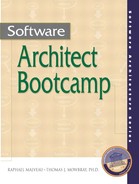A.11. Core Workflows
These are core business processes of the TRRS organization. They provide supporting information for the primary use cases.
UC004 Product Entry Workflow
Key Actors: Product Vendor
Context: Workflow initiating with the creation of a new product entry in the TRRS system.
Vendor collects product data sheets and standards references to prepare for submission to TRRS.
Vendor selects product features from TRRS categories to create a class features list.
Vendor selects standards for asserting product conformance by completing conformance forms.
Vendor identifies product's interoperability capabilities, completing interoperability forms.
Vendor establishes linkages to own product information and external documentation.
The product entry is committed to the TRRS system product directory.
The product conformance and interoperability templates are entered into a workflow queue to solicit the following kinds of TRRS entries (see use cases UC005 and UC006):
Standards Testing
Independent Testing
User Experience Reports
UC004 Extension: Vendor nominates an additional feature category.
UC005 COTS Validation Workflow
Key Actors: Testing Labs, Solution Providers, IT Users, Product Organizations Context: Workflow initiated when new conformance statements are asserted.
Conformance statements are sent to independent evaluators, including Testing Labs, Solution Providers, and IT Users, soliciting test and experience inputs.
Independent laboratory test generates test results, entered in TRRS system as experience report (see UC003).
Solution providers using the product in systems development submit integration testing experience reports (UC003).
IT Users submit usability results as experience reports (UC003).
Continue with UC007.
UC006 Interoperability Validation Workflow
Key Actors: Independent Evaluators: IT Users, Testing Labs, Solution Providers, two or more Product Vendors.
Context: Workflow initiated when new interoperability statements are asserted.
Interoperability statements are sent to independent evaluators.
Evaluators perform interoperability tests, product integrations, and usability experiments.
Evaluators submit results to the TRRS as experience reports.
Continue with UC007.
Extension (from Step 3 above): Interoperability Solution
Solution provider or third-party vendor may create an interoperability solution between two or more products.
The interoperability solution can be registered with the TRRS as a product with these asserted interoperability statements.
Solution providers can report their level of effort to create the interoperability solution.
UC007 Experience Report Update
Vendor assesses the experience report submissions.
Vendor concurs with each report(See Extensions A and B.)
Report is stored and published in TRRS system.
Extension A: Vendor does not concur (as in Step 2 above).
Vendor does not concur with experience report
TRRS returns report to author with comment.
Author modifies report and resubmits. (Resume from Step 2 above.)
Extension B: Deadline Passes
Context: Vendor does not concur
Sixty days pass since vendor has received report without concurring.
Report is stored and published in TRRS system.
